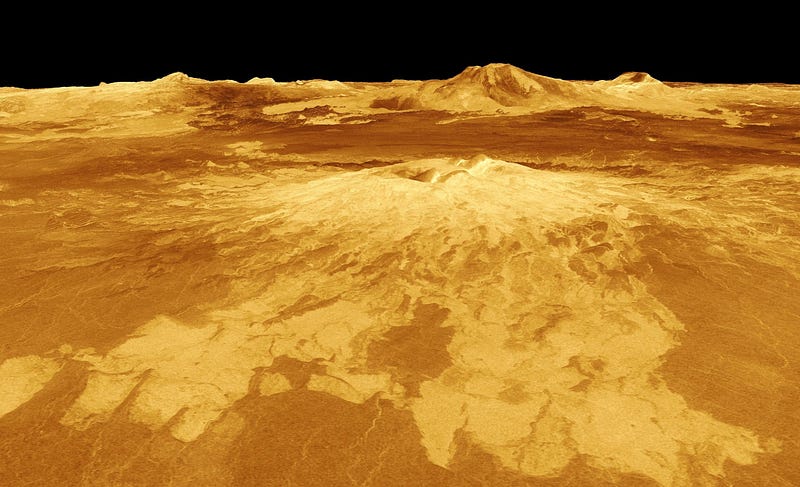Did Venus Once Have Earth-Like Plate Tectonics?
Written on
Chapter 1: Venus and Earth: A Comparative Study
Despite often being labeled as Earth's "sister" or "twin" due to their comparable size, mass, and composition, Venus and Earth differ significantly in many aspects. Venus experiences extreme surface temperatures of approximately 464 °C (867 °F) and features an atmosphere composed of over 96% carbon dioxide, resulting in incredibly high surface pressure. However, researchers from Brown University have uncovered a fascinating possibility: Venus may have once possessed active plate tectonics akin to those on Earth, as detailed in a study published in Nature Astronomy.

This image showcases Venus’ surface features captured during a flyby by the Parker Solar Probe in February 2022. Credit: NASA/APL/NRL.
Section 1.1: The Role of Plate Tectonics on Earth
Plate tectonics are crucial to Earth's geological processes. The movement of large crustal plates shapes mountains, volcanoes, and continents, renewing crust through the formation of new material at mid-ocean ridges while subducting older crust at convergent boundaries. This ongoing activity drives the rock cycle, facilitating constant physical and chemical transformations of the Earth's surface.
Moreover, active plate tectonics have significantly influenced the conditions necessary for life on Earth. The dynamic process of crust creation and destruction impacts the carbon cycle, releasing carbon into the atmosphere at mid-ocean ridges while recycling it from old crust back into the mantle. Over millions of years, this interplay between tectonics and the carbon cycle has stabilized atmospheric carbon levels, creating a conducive environment for life to thrive, in stark contrast to Venus' runaway greenhouse effect.

This computer-generated 3D perspective view illustrates the surface of Venus. Credit: NASA/JPL-Caltech.
Section 1.2: The Stagnant Lid Model
Historically, scientists believed that Venus’ intense heat stemmed from its atmospheric make-up and a "stagnant lid" convection model, indicating that the planet consists of a single crustal plate. This model has been applied to both Venus and Mars, as neither planet exhibits the active plate movements characteristic of Earth. As a result, heat transfer between the mantle and crust occurs solely via convection.
Research into the differences between Venus and Mars has prompted questions about how Venus acquired its high carbon dioxide and nitrogen levels. The recent findings from Brown University propose that Venus likely exhibited plate tectonics approximately 4.5 to 3.5 billion years ago, shortly after its formation. At that time, the degree of tectonic activity would have depended on the number of plates present on its surface. Notably, Venus may have shared similar tectonic activity with Earth during their early development.
“One of the key insights is that we likely had two planets operating under a plate tectonic regime simultaneously, a process that facilitated life on Earth today.” — Matt Weller, lead author.
Chapter 2: Insights into Venus’ Geological History
To better understand Venus’ formation and current state, the Brown University team analyzed contemporary atmospheric data, concluding that a stagnant lid alone could not account for the current atmospheric composition and pressure. Their simulations indicate that a combination of limited tectonic movement in Venus' early history, followed by a stagnant lid, aligns with today’s conditions. Notably, recent studies (2020 and 2023) suggest that Venus remains volcanically active, hinting at some ongoing geological processes.
This video titled "Why Plate Tectonics Is SO IMPORTANT for Venus" delves deeper into the significance of plate tectonics in understanding Venus' geological features and history.
Section 2.1: Implications for the Search for Extraterrestrial Life
The authors of the study argue that our perspective on plate tectonics has been overly simplistic, viewing it as either present or absent. Their modeling suggests that a planet can experience active tectonics at one point and then become inactive later. This raises the possibility that Venus could have had habitable conditions at some stage in its history, potentially supporting microbial life.
Co-author Alexander Evans indicates that other rocky planets might similarly transition in and out of habitability based on changes in their tectonic and internal processes. The study also emphasizes the need to consider past tectonic activity when investigating the moons of Jupiter and Saturn, particularly Europa, which has recently been found to potentially have active plate tectonics and is a focal point for astrobiological research due to its subsurface ocean.
The video "Turns Out, Venus May Have Unique Plate Tectonics... kinda like Earth?" explores the complexities of Venus' geological history and its similarities with Earth.
Finally, this research may enhance our understanding of Earth's formation and its unique capacity to support life, serving as a cautionary tale of what could happen to Earth-like planets when carbon dioxide levels rise unchecked.
“That’s the next crucial step in comprehending Venus, its evolution, and ultimately Earth's fate. What conditions could lead us toward a Venus-like scenario, and how can we ensure Earth remains habitable?” — Matt Weller.